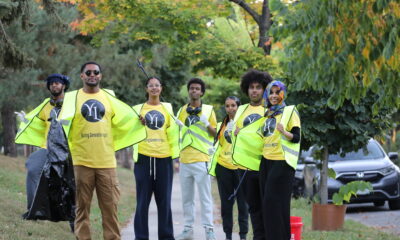Health
Attention, Minnesota! Measles Outbreak Alert

Minnesota –
The Minnesota Department of Health (MDH) confirmed measles outbreak. This highly contagious virus can be serious, especially for young children and those with weakened immune systems. Here’s what you need to know:
![]() What is Measles? A viral infection that causes a high fever, cough, runny nose, and a characteristic rash. It can lead to complications like pneumonia and encephalitis.
What is Measles? A viral infection that causes a high fever, cough, runny nose, and a characteristic rash. It can lead to complications like pneumonia and encephalitis.
![]() Symptoms to Watch For: Fever, cough, runny nose, and a red, blotchy rash that typically starts on the face and spreads.
Symptoms to Watch For: Fever, cough, runny nose, and a red, blotchy rash that typically starts on the face and spreads.
![]() Prevention: The best defense is vaccination. Ensure you and your family are up-to-date with the MMR (measles, mumps, and rubella) vaccine. It’s safe and highly effective.
Prevention: The best defense is vaccination. Ensure you and your family are up-to-date with the MMR (measles, mumps, and rubella) vaccine. It’s safe and highly effective.
![]() If You Suspect Infection: Contact your healthcare provider immediately and avoid public places to prevent spreading the virus.
If You Suspect Infection: Contact your healthcare provider immediately and avoid public places to prevent spreading the virus.
Your vigilance can help protect our community. For more information and updates, check with local health authorities and healthcare providers.
Stay safe and informed! https://www.health.state.mn.us/diseases/measles/index.html
Health
City of Minneapolis Launches First NARCAN Vending Machine on the Northside

Minneapolis – In a groundbreaking effort to expand access to life-saving overdose intervention tools, the Minneapolis Health Department, in partnership with Hennepin County, has installed the first NARCAN vending machine in North Minneapolis. The machine is located at Fire Station 14, which also operates as the City’s Safe Station—a trusted and welcoming space for individuals seeking help with substance use and recovery.

The vending machine is stocked with more than 100 boxes of NARCAN, with each box containing two doses of the opioid overdose reversal medication. It is accessible 24/7 and available at no cost—no ID, insurance, or appointments required.
Fire Station 14 serves as more than just an emergency response hub—it’s a point of connection. Those who walk through its doors can access peer recovery specialists and a network of support services aimed at helping people take the next step in their recovery journey.
Support is here, and it’s closer than you think. By putting tools like NARCAN directly into the hands of community members, Minneapolis is taking a vital step toward building healthier, more resilient neighborhoods.
Watch the announcement: https://www.youtube.com/live/K6HeebdcXL0
Find resources: https://www.minneapolismn.gov/…/current-concerns/opioids/

Health
E. coli O157 infections linked to consumption of burgers from Twin Cities restaurants

Health officials are urging people to contact their health care provider if they ate a hamburger, especially if undercooked, at a table-service restaurant since Oct. 31 and then developed diarrhea, particularly bloody diarrhea, in the following week.
The Minnesota Department of Health (MDH) has identified 10 cases of E. coli O157 infection in people who had eaten burgers at multiple locations of Red Cow, a table-service restaurant chain with locations in Hennepin, Ramsey and Olmsted counties. One additional case reported dining at Hen House Eatery in Minneapolis, which received the same ground beef product suspected in this investigation. The ground beef product was also distributed to other establishments, so additional cases from other locations could be identified.
So far, cases have reported meal dates of Oct. 31 through Nov. 7, and illness onset dates range from Nov. 4 through Nov. 9. Cases range in age from 9 to 70 years. Two cases have been hospitalized. Additional potential cases are under investigation.
Red Cow and Hen House Eatery owners are fully cooperating with the investigation and have made multiple changes, including product changes, to prevent further illnesses. MDH is working with the Minnesota Department of Agriculture and multiple local environmental health agencies during this ongoing investigation.
Symptoms of illness caused by E. coli O157 typically include stomach cramps and diarrhea, often with bloody stools, but only a low-grade or no fever. People typically become ill two to five days after exposure, but this period can range from one to eight days. Most people recover in five to 10 days. However, about 5% of E. coli O157 infections lead to hemolytic uremic syndrome (HUS), a severe complication that involves acute kidney failure and other severe problems. Treatment with fluids can help prevent HUS, but E. coli O157 gastroenteritis should not be treated with antibiotics, which can increase the likelihood of HUS.
Anyone who believes they may have developed an E. coli O157 infection should contact their health care provider.
Approximately 100 cases of E. coli O157 infection are reported each year in Minnesota. More information on E. coli O157 and how to prevent it can be found on the MDH E. coli website.
-MDH-
Health
Effects of Tobacco on Mental Health

Background
Historical development of the conversations regarding mental health have not been progressing as rapidly as one would prefer. We have gained greater knowledge about mental illness over the last 20 years, and the majority of us now believe that therapy works. But there’s a growing societal perception that those with mental illness are unpredictable and dangerous.Studies have indicated that smoking exacerbates stress and anxiety. Smokers believe smoking lowers stress and anxiety because nicotine instantly relaxes them. This sensation is fleeting and is quickly followed by cravings and withdrawal symptoms. Furthermore, there is a great deal of stigma attached to drug addiction problems, and people often blame those who are ill for their habits. Many people are hesitant to seek treatment or disclose their disease in public due to these misconceptions and biases.
Understanding the Chemical Effect
Dopamine is released in the brain in response to stimulation by nicotine. Dopamine has a role in eliciting happy emotions. People with depression frequently have low levels of it, and as a result, they may smoke cigarettes to momentarily boost their dopamine levels. Smoking, however, causes the brain to turn off the process by which it produces dopamine, which eventually results in a decrease in supply and an increase in smoking.When trying to quit smoking, people with depression may find it very difficult and have more acute withdrawal symptoms. Never forget that if you want to stop, there is a ton of help available. You don’t have to experience it alone, though.
Coping and Seeking Help
Avoid isolating yourself. It’s possible that you’re reluctant to disclose your mental health condition to others. If your loved ones, friends, clergy, or neighbors are aware of your mental health condition, they can help you. Seek the empathy, understanding, and support you require from those you can trust. There is a misplaced stigma in the East African community when it comes to mental illness. However, this should not stop one from seeking the help they need.
Support from friends and family might make quitting smoking easier. Encourage your friends or cohabitants who smoke to quit smoking if you live with them. Even for people who have managed to abstain from smoking for more than a year, having a mental illness at the time of quitting increases the likelihood of relapsing into smoking. For the same reasons that others have mentioned (health and family), many smokers with mental illnesses wish to stop, but they may be more susceptible to relapse due to stress and other unpleasant emotions.
Article by WellShare International
-

 Local News12 months ago
Local News12 months agoGovernor Walz Announces Minnesota Ranked as a Top State for Business
-

 Local News9 months ago
Local News9 months agoCelebrating Community: The Inaugural Samafal Gala at the Minnesota Somali Community Center
-

 Community9 months ago
Community9 months agoYouth Leader and Mentor: Mohamed Jama’s Fight for Change in Whittier
-

 Local News3 months ago
Local News3 months agoCouncilmember Osman’s Statement on Violence Interrupter Services in Cedar Riverside and Elliot Park
-

 Health9 months ago
Health9 months agoEffects of Tobacco on Mental Health
-

 Local News9 months ago
Local News9 months agoIkran Mohamed Becomes the First Woman Somali American Police Officer to join Minneapolis Police Department
-

 Local News2 months ago
Local News2 months agoLake Street Lift Launches “Lake of 10,000 Lands” Campaign
-

 Health8 months ago
Health8 months agoE. coli O157 infections linked to consumption of burgers from Twin Cities restaurants

















